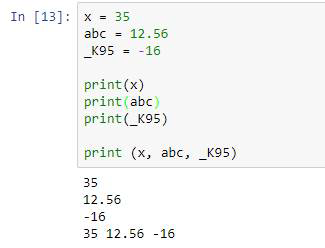2-1 資料型態
PRINT:永遠是跟世界打聲招呼的第一個程式
print語法是在print函式中放進你要印的東西,比如 print(我要印這個)。說聲 Hello World,跟程式的世界打聲招呼吧!
第一個跟世界打招呼的程式!
print的內容可以是變數(variable): print(a),數字(init): print(1234),或是字串(string): print(‘abc123’)
- 容器,可以存放資料
- 變數名稱有區分大小寫!
- 命名原則:第一個字元必須是英文字,其餘可用英文、數字及底線符號
- 不能單獨使用保留字當成變數名稱,包括:
- and as assert break class continue def del elif else except exec finally for from global
- if import in is lambda not or pass print raise return try while with yield
變數在程式中,扮演中儲存資料的角色。將資料儲存下來,就可在需要的時候拿出來用。
在程式中,每個變數會有自己的型別。那型別是什麼呢? 簡單來說,型別決定了這個變數可用來儲存什麼樣格式的資料,並且定義了相對應的操作。
簡單舉例,Python中常見的基本型別有:int (整數)、float (浮點數)、str (字串)。
從上述你大概可以知道,如果要今天存放年齡,整數會是不錯的選擇。
身高 & 體重? 浮點數看來不錯。 名字? 字串是不二之選!
不過在Python中,宣告變數並不用事先給定型別,他會依照你給他的初始值來決定變數的型別。
- int(x [,base]) Converts x to an integer. The base specifies the base if x is a string.
- float(x) Converts x to a floating-point number.
- complex(real [,imag]) Creates a complex number.
- str(x) Converts object x to a string representation.
- repr(x) Converts object x to an expression string.
- eval(str) Evaluates a string and returns an object.
- tuple(s) Converts s to a tuple.
- list(s) Converts s to a list.
- set(s) Converts s to a set.
- dict(d) Creates a dictionary. d must be a sequence of (key,value) tuples.
- frozenset(s) Converts s to a frozen set.
- chr(x) Converts an integer to a character.
- unichr(x) Converts an integer to a Unicode character.
- ord(x) Converts a single character to its integer value.
- hex(x) Converts an integer to a hexadecimal string.
- oct(x) Converts an integer to an octal string.
練習1: 請寫一個程式,輸入華氏溫度,輸出攝氏溫度
測試資料: 華氏=100 攝氏=37.77...
華氏=10 攝氏=-12.22...
練習2: 請寫一個程式,輸入攝氏溫度,輸出華氏溫度
測試資料: 攝氏=-12.22 華氏=10.00...
攝氏=37.77 華氏=99.99...
練習3: 畢氏定理→輸入直角三角形的兩股(a,b)長度,算出斜邊(c)的長度
練習4:輸入a,b,c三值,輸出一元二次方程式的兩個根 (提示: 3的平方寫法 3**2 )
測試資料: a=1 b=-3 c=2 x1=2.0 x2=1.0
a=4 b=-5 c=1 x1=1.0 x2=0.25
提示
攝氏 = (華式-32) * 5/9

